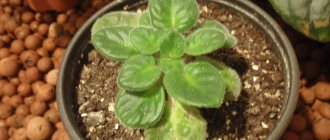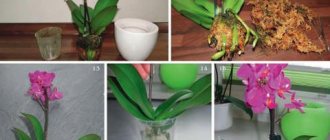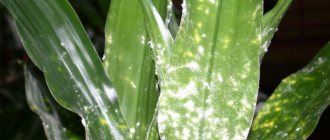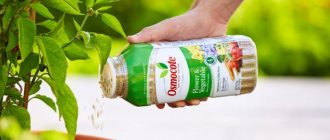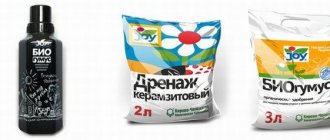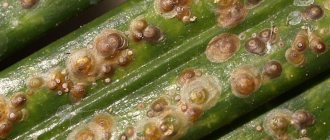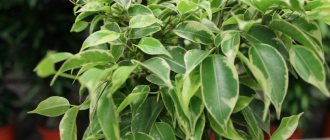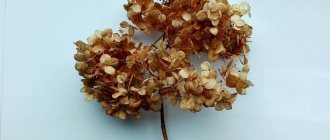◾spraying flowers with a solution of succinic acid even once every few weeks will significantly enhance their growth and development. ... To achieve this, spraying can be carried out before flowering begins, and the treatment can be carried out several times. Water the ground under the violet with a working solution once a month. Succinic acid is used on violets once a month. The composition of succinic acid mixed with potassium humate in a 1:1 ratio shows high efficiency. This will greatly strengthen the immune system and activate flower growth.
How to dilute Amber for indoor plants?
Solution – 0.4 g/1 l of water (80 ml of Amber per 1 l of water). Treatment - immersing the plant “upside down” in the solution so that it does not get into the axils of the leaves. Processing time is half an hour.
Interesting materials:
What percentage of women cheat on their husbands? What is the cost of living in Belarus 2022? How long will your SSD last? How many posts can you post on Instagram? How many empty pallets are included in a gazelle? How long does it take for dental sutures to dissolve? How many times has Messi won the Golden Boot? How many times can you use the same sheet mask? How many times do you have to do pull-ups in the army? How many times a day should you feed the praying mantis?
Succinic acid for violets
This is a natural compound that is present in small concentrations in the cell of every living organism. It is a regulator of energy metabolism necessary for the body to obtain vital energy.
Characteristics
Succinic or butadionic acid (C4H6O4) belongs to the group of dibasic saturated carboxylic acids. It is a by-product of amber processing; industrially it is obtained through chemical synthesis.
Succinic acid.
The acid is a white, translucent crystalline substance easily soluble in water, alcohol and ether.
In plant growing it is used only in the form of aqueous solutions. This compound is especially useful when caring for potted plants, where there is no natural supply of beneficial elements and microorganisms.
Release form
Succinic acid is available in the form:
- tablets of 50 and 100 mg in blister;
- powder, packaged in plastic bags of 1, 5, 10, 25 kg.
It is used in very small doses, so it is better to purchase the drug in tablet form.
Features and Properties
The features of succinic acid as a plant biostimulator are determined by its natural origin:
- due to its weakly expressed stimulating effect, it can be used to treat all parts of the plant ;
- application of the drug promotes the development of soil microflora ;
- acid does not accumulate in soil and plants and quickly decomposes under natural conditions;
- low cost of the drug.
Attention! The drug cannot be used as a supplement; it is effective as a stimulant in recommended concentrations.
A positive result will be noticeable within a month. And you can be absolutely sure that there will be no negative consequences for your flower.
Advantages and disadvantages
The biostimulator has a wide spectrum of action , under its influence:
- immunity is increased and the risk of flower damage by pests and microbial infections is reduced;
- cellular metabolism is activated, as a result, the growth of the above-ground and root parts of plants is accelerated;
- improves the absorption of nutrients by roots;
- stimulates chlorophyll synthesis in leaves;
- promotes rapid recovery of the flower after stress caused by transplantation or change in conditions.
Succinic acid can be used for any plants.
Notable disadvantages include:
- relatively weak overall effect on the plant;
- increasing soil acidity with repeated use, this is especially true for potted crops.
To avoid soil acidification, it is necessary to control the pH of the soil and, if necessary, carry out liming.
Forum of flower growers Frau Flora
About growing indoor and garden plants; discussion of species, varieties, diseases, pests.
- Unanswered topics
- Active topics
- Search
- About Us
succinic acid
Moderator: Murzilka
succinic acid
Post by qwestxxx » Feb 23, 2022 12:57 pm
Succinic acid I am interested in the topic of fertilizing indoor plants with succinic acid. I bought succinic acid in liquid form at the store. And I can’t find anywhere how to dilute it (for example, for orchids, violets, and in general for different indoor flowers); everywhere they give proportions for powder or tablets. But how to dilute liquid? in what proportions? How often should I water the plants? There is a general table in the instructions for use that is not at all informative. Maybe in this form it is not suitable for indoor plants at all?
succinic acid
Post by Lucina » 23 Feb 2022, 13:17
succinic acid
Message by LoveN » 23 Feb 2022, 13:37
succinic acid
Post by Lucina » 23 Feb 2022, 15:31
succinic acid
Post by GalinaGala » 23 Feb 2022, 17:49
succinic acid
Post by Lucina » 23 Feb 2022, 20:06
Fertilizers for indoor plants
Post by Lucina » 24 Feb 2022, 15:26
succinic acid
Post by Florian » 24 Feb 2022, 16:15
During what periods is it better to refrain from fertilizing?
You should not feed violets at the development stage.
The plant may not always need feeding:
- transplanted plants. A month for sure. Or even more;
- After purchasing in the store, do not start fertilizing for 2-3 weeks;
- If temperatures from the recommended ones;
- Stop feeding if you find bugs, mites, aphids or other unwanted guests;
- nitrogen fertilizers when buds appear;
- Fertilizers should not be applied to dry soil. First, water with plain water.
Reviews
Elena. The first time I decided to use succinic acid was when my ageratums began to wither. The stems were very thin and weak, and it was already time to transplant the flowers into the flowerbed. Having listened to the advice of a neighbor, I decided to treat the root system of plants with succinic acid and did not regret it. After planting in the flower garden, the seedlings did not hurt at all and began to bush very strongly. The flowers also tolerated the heat well, not like before. So I can recommend this bait without fear.
Maria. Since childhood, I have loved growing flowers. In the apartment, all the window sills are filled with plants in various pots. I am already accustomed to periodically using succinic acid for all my home flowers. The result is always pleasing.
Olga. I have been using this acid for a long time, I buy it at a regular pharmacy. Moreover, I add to her not only indoor flowers, but also those that grow in the flowerbed next to the house.
Negative consequences of improper watering
How to water gooseberries in summer - the best watering methods
Lack of moisture or its excess has a bad effect on the condition of the violet, leading to gradual death:
- Excessive moisture - the roots die, spots appear on the leaves. This occurs due to the fact that water stands in the ground, preventing nutrients from passing through.
- Flooding of flower organs during top watering means rotting of the growing point.
- If water gets on the leaves when watering from above, brown and yellow spots appear.
- Lack of water - leaves wither and fall off.
- Using too hard a liquid will result in a yellow-white crust appearing on the top layer of soil.
- Infrequent watering - a space is formed between the soil and the walls of the container.
Improper watering leads to the slow death of the plant.
Excessive watering can lead to the appearance of mold on the ground. Because of it, the soil is less permeable to air, and the roots cannot fully “breathe.”
Instructions for use
Depending on the goal, violet processing is carried out in different ways. Before starting work, prepare a working solution.
Preparation of working solution
The finished solution can contain from 0.01 to 0.1% of the active substance, the universal solution contains 0.02% acid. The acid concentration in the solution is:
- for wiping the leaf blade 2 g / liter of water;
- when spraying – 2 g/liter of water;
- when watering the roots - 3 g/liter of water;
First prepare the concentrate:
- 1 g of the substance is dissolved in 50 ml of warm water;
- add cold water to a liter.
To obtain a 0.02% working solution, add 0.8 liters of cold water to 200 ml of the resulting concentrate.
Based on the data obtained, you can calculate how to use succinic acid for violets in tablets, knowing the dosage of the active substance. So, with a tablet dosage of 100 mg, to obtain 1 g of succinic acid you need to take 10 tablets.
The prepared solution is stored for no more than 3 days; at the end of this period it is poured out.
Watering
Water the ground under the violet with a working solution once a month.
Succinic acid is used on violets once a month.
The composition of succinic acid mixed with potassium humate in a 1:1 ratio shows high efficiency. This will greatly strengthen the immune system and activate flower growth.
Spraying
At the first signs of violet disease, it is recommended on both sides once or twice a month . If necessary, the number of treatments can be increased.
Important! Constant stimulation of the violet exhausts the plant and disrupts its natural rhythm.
It is enough to spray a healthy plant once a month.
Stimulation of flowering
On gardening forums, succinic acid for violets and how to make them bloom are often discussed. It is worth understanding that there is no panacea in this matter, however, spraying violets before flowering begins to noticeably affect the development of buds:
- their number increases;
- the leaves become bright green.
The use of succinic acid makes flowering more magnificent.
Before flowering, treatment is carried out once a week.
Increased root formation in cuttings and children
Treatment of the root system before planting violets promotes rapid rooting of the flower:
- the root is immersed in the working solution for 60 minutes;
- dry for about half an hour;
- The violet is planted in the soil mixture.
In order for the rooting of cuttings to be successful, a cut of the cutting is immersed 2 cm in a working acid solution, the exposure time is several hours.
From time to time, daughter plants - stepchildren - develop from the buds located between the leaves of the violet. They are usually removed to leave one growing point, but they can also be used for propagation.
In this case, the formation of stepsons on the violet can be stimulated by pinching the growing point or cutting off the top of the rosette, which can then be rooted. Such manipulations initiate the growth of a large number of stepchildren.
Overdose
Exceeding the dosage of the drug does not pose any risks for violets , since the roots are able to absorb only a small part of this compound.
Basic watering methods
There are several watering methods. You need to know which one is suitable for indoor violets so that it feels good and develops fully.
Upper
This is a classic watering method that can be used to care for violets.
Attention! When top watering, do not place a sprayer on the watering can. Watering the leaves is strictly prohibited
The essence of the method is that the water should only get under the root or be absorbed by the soil around the edges of the pot. It is best to use a syringe without a needle, a watering can with a very narrow nose, or a syringe. The liquid must be poured until it appears at the bottom of the pan. Its excess is removed after 20 minutes.
When top watering, it is forbidden to pour water on the leaves.
Through the pallet
This method is recommended for use during the cold season. Water is poured directly into the pot's base until the soil stops absorbing it. After 15 minutes, the residues are drained.
Capillary
The technique is used for young violets. Several pots are placed in one box. A capillary mat is placed on the bottom. It is a piece of non-woven material that is saturated with liquid and holds it for a long time.
Plants that stand on the mat gradually absorb water through their roots. This method is preferable because the flowers constantly receive moisture. The method reliably protects the soil from drying out.
Wick
The method is suitable for those who are forced to leave home for a long time. Thanks to the use of a wick, the liquid will flow drop by drop to the flower for a long time.
One end of the wick is lowered into a container of water, the other end is inserted into the drainage hole in the flowerpot. If the flowerpot is small, you can use a plastic glass. Water is poured into it, the container with the violet is placed on top, but so as not to touch the liquid. The wick is in the water and rises into the drainage hole.
The wick method of irrigation is one of the most suitable; it makes it possible to saturate the plant with moisture for a long time
For reference! You can use a regular shoe lace as a wick.
Dive
This method of watering is known as Texas method. Flowers really like it, but the gardener will have to spend time and effort to create the conditions for its organization.
Holes are made on the sides of the flowerpot at a height of 5 cm from the bottom of the container. Perlite is laid up to the level of the holes, with earth on top. The container with the flower is placed in the ditch, the liquid is poured until the holes are made.
It is impossible to drown the holes with water, so as not to block the access of oxygen to the roots. When using this method of irrigation, it is recommended to choose fibrous peat soil.
Possible harm
An overdose of succinic acid does not have a negative effect on plants. They use the amount of feeding they need.
But when spraying, you should not overdo it with the concentration of the beneficial substance. A strong solution may leave burns on the foliage.
Frequent use of succinic acid solution leads to soil oxidation. To combat this effect, you can use lime by adding it to the substrate.
Succinic acid helps stimulate the necessary life processes of flowers. It can be used for healthy cultures and treatment, resuscitation of needy specimens.
For each case, a solution is prepared with a different concentration of dicarboxylic acid. A strong acidic composition will be required in the fight against pests and infections. When caring for and stimulating flowering, weak mixtures are sufficient.
Dicarboxylic acid can be used for watering, spraying and soaking plants. But it is necessary to observe the correct dilution proportions and frequency of application of fertilizing.
Otherwise, you can achieve a negative effect. Choosing food for indoor plants is not easy. It is the amber composition that compensates for the lack of nutrients in the soil.
